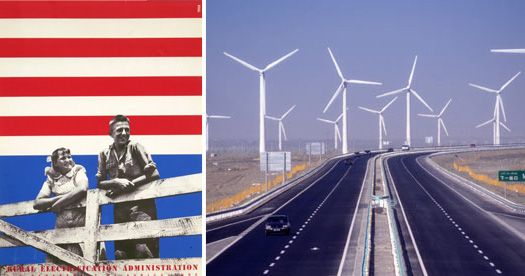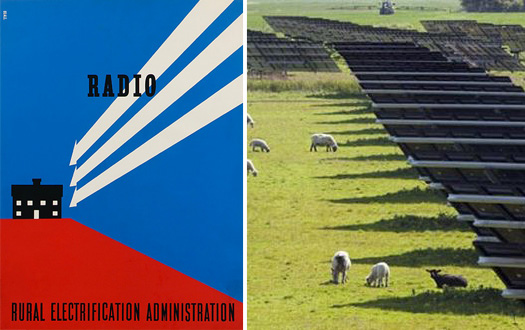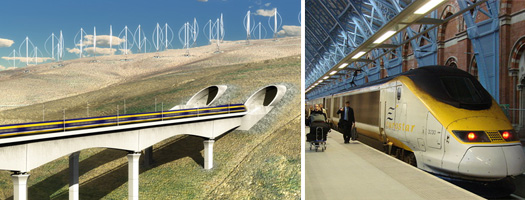
We are celebrating 15 years — and counting — of stories that are deeply researched and deeply felt, that build a historical record of what the city has been.
We are celebrating 15 years — and counting — of stories that are deeply researched and deeply felt, that build a historical record of what the city has been.
Last week, Massachusetts voted in Senator-elect Scott Brown and his pickup truck, the Supreme Court ruled that money does indeed talk, and in what might be fairly characterized as grade inflation, Brookings gave the Obama administration an “A-” on infrastructure investment. These events – which took place during one of the most sobering humanitarian crises this hemisphere has ever seen – make vivid the extent to which the era of Change We Can Believe In is, at best, an exercise in muddling through. If the top-down big vision only leads to blinding, reactionary anger, is the answer to take smaller steps, to retreat into our corners, ignore the morass of government and try to innovate by ourselves from the bottom-up? Or is it to take stock of the range of good ideas currently on offer and marshal them towards a passionate call to action? The kind of action that looks to our past while always facing forward. The kind that’s neither top-down nor bottom-up but laterally networked.
Also last week, Nancy Levinson, editor of the journal Places, did just that: she summarizes some recent provocative positions on American infrastructure in order to challenge designers to do nothing less than reimagine the relationship between individual initiative and political community. This week, we’ve reposted her essay in hope that it starts a new kind of conversation about what public, and public works, really means. – C.S.

Left: Rural Electrification Administration, poster design by Lester Beall, 1934. Right: Wind Farm, China, 2009.
Today Americans may be divided, but they share the knowledge that something is deeply wrong. Two-thirds of the housing in Phoenix is in foreclosure. . . Unemployment rates in exurban California and Las Vegas are several points higher than in denser areas . . . because most exurbs have no industry other than real estate itself. . . . Among the leading killers in America are cardiovascular disease and adult onset diabetes, [lifestyle-related illnesses] which used to rank much further down. Our young men and women are dying in the mountains of Afghanistan, struggling against an enemy funded by an Arabian peninsula we have enriched because of a profligate lifestyle we have endorsed. – Vishaan Chakrabarti, “Being Dense about Denmark,” Urban Omnibus, December 16, 2009
Americans would like things to be better . . . Everyone would like their child to have improved life chances at birth. . . They would appreciate full medical coverage at lower cost, longer life expectancy, better public services, and less crime. . . In the US today, we have a discredited state and inadequate public resources. – Tony Judt, “What Is Living and What Is Dead in Social Democracy,” New York Review of Books, December 17, 2009
Let us never forget that government is ourselves and not an alien power over us. – Franklin Delano Roosevelt, July 8, 1938
Yes indeed, today in America we know that something is wrong, and we would like things to be better. Certainly the design disciplines have been energetic in engaging the converging crises of energy, housing, infrastructure, environment, climate change. In his recent essay on Urban Omnibus, Vishaan Chakrabarti, director of the Real Estate Development Program at Columbia, argues passionately for legislation that would produce “a country of cities.” Chakrabarti expresses his frustration — shared by many in the design community — that Obama and his advisors have failed to grapple with the root causes of the crises, which is the American way of life, “our profligate consumption,” the big house and the wide highway and the exurban spread. And he imagines what might have been a “very different first year for the administration,” with the creation of a big new program, the “American Smart Infrastructure Act,” or ASIA. “After the $700 billion TARP bailout, in which banks were said to be too big to fail,” he writes, “we could have been told that the nation and world were, in fact, too big to fail.” Chakrabarti describes his ASIA:
“We will build and rebuild infrastructure that lowers greenhouse gas emissions and encourages urban density, emphasizing high-speed rail, transmission grids from alternative energy sources, national internet broadband, and critical roadway maintenance. We will deemphasize all infrastructure that exacerbates emissions, particularly roadway and airport expansion projects. The government will fund approximately $350 billion (about half of TARP) over three years, solving the nation’s mobility needs while lowering automobile use and censuring the energy devoured by McMansions.”

Left: Hoover Dam, 1938 (Library of Congress; unidentified photographer); Right: Horns Rev Wind Farm, Denmark, North Sea, 2007.
A similar sense of urgency and idealism has inspired cityLab, the urban design think tank at UCLA, to create WPA 2.0, a multidimensional program that Linda Samuels profiled earlier this week in Places. Samuels describes the WPA 2.0 design competition held last year and the high-powered symposium that followed in Washington, D.C., both of which promote an ambitious agenda for America’s infrastructure and cities. As she notes, in the finalists’ projects, “infrastructure is expanded in scope,” with each team tackling a difficult issue — drought, pollution, immigration, etc. — and generating designs that not only solve technical problems but also envision new amenities. Here is Samuels’s description of the winning project, Carbon T.A.P.//Tunnel Algae Park: “The project aims to transform zones of concentrated carbon dioxide emissions through new green infrastructure that would not only sequester carbon but also create public spaces. Sited above the Brooklyn-Battery Tunnel in New York, the project deploys pontoon-like, pivoting piers that combine carbon-generated algae farming and biofuel production with wildlife habitats and bicycle and pedestrian paths. The result is a dramatic reinvention of the urban waterfront.”
Chakrabarti’s ASIA, cityLab’s WPA 2.0 — each underscores the eagerness of the design disciplines to participate in a contemporary rebuilding program as bold and far-reaching as the original WPA, the Works Progress Administration, the biggest of FDR’s New Deal agencies of the 1930s, created in response to the Great Depression. This is an eagerness I share: as director of the Phoenix Urban Research Lab, at Arizona State University, I worked with architecture and landscape architecture colleagues to develop our own big-picture, wicked-problem project — Post-Petroleum Phoenix, a multiyear initiative with the goal of producing design and policy guidelines for the creative adaptation of the low-density, car-centric city over the next half century.
And yet it seems increasingly — depressingly — clear that the Great Recession is not (yet) sparking a new New Deal, a contemporary WPA. The New Deal was a big-scale, legacy-building, vision-to-burn public sector response to national crisis. But in 2010, unlike in the ’30s, we confront our crisis in a social-political climate that’s to a large degree contemptuous of public sector solutions, and more, hostile to the very idea of the public.
This dilemma is brilliantly analyzed by the historian Tony Judt in “What is Living and What is Dead in Social Democracy,” published recently in the New York Review of Books. Here I can only suggest the scope of Judt’s long and incisive essay, which goes far toward explaining the current dissonance — the fact that we want things to be better, yet fail to support the actions that would make them better. [1]

Rural Electrification Administration, silkscreen by Lester Bell, 1937. Right: Solarpark in Rodenas, North Friesland, Germany, circa 2009 (via the Guardian)
How have we gotten to this contradictory moment? Judt illuminates decades of political and economic debate between the Chicago School free marketers, on one side, and the social-democratic adherents of John Maynard Keynes, on the other, in order to trace “the history of a prejudice, the universal contemporary resort to ‘economism,’ or the invocation of economics in all discussions of public affairs.” He goes on: “For the last thirty years, in much of the English-speaking world (though less so in continental Europe and elsewhere), when asking ourselves whether we support a proposal or initiative, we have not asked, is it good or bad? Instead we inquire: Is it efficient? Is it productive? Would it benefit gross domestic product? Will it contribute to growth? This propensity to avoid moral considerations, to restrict ourselves to issues of profit and loss — economic questions in the narrowest sense — is not an instinctive human condition. It is an acquired taste.” [2]
What has been central to the triumph of economism, in Judt’s persuasive argument, is the galloping pace of privatization. Again in the past thirty years, he writes, “A cult of privatization has mesmerized Western (and many non-Western) governments. . . . What we have been watching these past decades is the steady shifting of public responsibility onto the private sector to no discernible collective advantage. . . . Most of the things that governments have seen fit to pass into the private sector were operating at a loss: whether they were railway companies, coal mines, postal services, or energy utilities, they cost more to provide and maintain than they could ever hope to attract in revenue.”
They cost more to provide and maintain than they could ever hope to attract in revenue. To Judt’s list one can readily add the kind of long-range reinvestment in infrastructure that Chakrabarti envisions, or the innovative projects inspired by WPA 2.0. Or the proposals being generated by MOMA’s Rising Currents, in which teams of designers address the likelihood of rising sea levels around New York City; or Growing Water, from UrbanLab, which proposes a network of eco-boulevards for Chicago; or Moving Cooler, a new report sponsored by the NRDC, which explores transportation strategies for reducing greenhouse gas emissions . . . this is a list that could go on and on, for we’re fortunate to live in an era of remarkable creativity across the design professions.

Left: Proposed High Speed Rail, California (via Livable Streets). Right: Eurostar High Speed Rail, St. Pancras Station, London, 2007 (photographer: Oxyman, via Wikimedia Commons)
But the implementation of this creativity will require what seems to have gone missing in American life, which is a sense of the collective, the conviction that not everything that’s worth paying for will pay for itself. Three decades on, the cult of privatization has blurred for us crucial distinctions between what’s optimally public and properly private, between the different strengths and capacities of each sector. [3] How might we revive these distinctions in order to tackle the profound problems we face — to move from the rhetoric of good intentions, and the sophisticated depiction of innovative design, to actual programs and policies and constructed works (which inevitably will be partial and imperfect)? Tony Judt put it this way: “We have to begin with the state: as the incarnation of collective interests, collective purposes, and collective goods. If we cannot learn to ‘think the state’ once again, we shall not get very far.”
To think the state: this is a discussion we designers need to delve into, for the most exciting and transformative work being proposed today — diversifying our transportation networks, greening the power grid, creating low-carbon neighborhoods, reducing pollution and promoting conservation — is of a scale and complexity that demands sustained public commitment and powerful legislative vision, not only to construct but to operate. Without the state, such work will not get very far. [4]
So what exactly do we do? The urge is to end on the upbeat — a call to action. And yet at this point the essential dilemma is so fundamental. It’s got less to do with anything as easily identifiable as (say) partisan politics or economic interests than with what underlies our political and economic culture — what George Orwell would have called our “mental atmosphere,” in which the balance, or imbalance, between private and public has become so naturalized as to seem inevitable, and we’ve forgotten that government is ourselves. “Why is it,” Tony Judt asks, “that here in the United States we have such difficulty even imagining a different sort of society from the one whose dysfunctions and inequalities trouble us so? We appear to have lost the capacity to question the present, much less offer alternatives to it. Why is it so beyond us to conceive of a different set of arrangements to our common advantage?”
There’s the challenge. To imagine a different sort of society, a different set of arrangements, with a reinvigorated public, and a new era of great public works.
Notes
1. The essay was adapted from an October 2009 talk at New York University, where Judt is director of the Remarque Institute and a University Professor. You can watch a video of the event here.
2. In the design world there is no more insidious instance of this acquired taste than the so-called Bilbao Effect, which seems to underscore the value of high architecture to urban redevelopment yet actually diminishes that value by narrowing it to “issues of profit and loss.” And of course this can boomerang if the redevelopment flops and the would-be Bilbao fails to produce the Effect.
3. It was in his First Inaugural Address — on January 20, 1981 — that Ronald Reagan declared: “In this present crisis, government is not the solution to our problem; government is the problem.”
4. Judt offers as an example the railway system: “Imagine, if you will, a railway station. A real railway station, not New York’s Pennsylvania Station: a failed 1960s-era shopping mall stacked above a coal cellar. I mean something like Waterloo Station in London, the Gare de l’Est in Paris, Mumbai’s dramatic Victoria Terminus, or Berlin’s magnificent new Hauptbahnhof. In these remarkable cathedrals of modern life, the private sector functions perfectly well in its place: there is no reason, after all, why newsstands or coffee bars should be run by the state. Anyone who can recall the desiccated, plastic-wrapped sandwiches of British Railway’s cafés will concede that competition in this arena is to be encouraged.
“But you cannot run trains competitively. Railways — like agriculture or the mails — are at one and the same time an economic activity and an essential public good. Moreover, you cannot render a railway system more efficient by placing two trains on a track and waiting to see which performs better: railways are a natural monopoly. . . .”
“The Public Works” originally appeared on Places on January 21, 2010 — be sure to read the thoughtful comment thread. Nancy Levinson is editor of Places. She brings to the role a range of experience in design and practice, most recently as the founding director of the Phoenix Urban Research Laboratory and a professor of practice at the School of Architecture + Landscape Architecture at Arizona State University. She received a B.A. from Yale University and Master of Architecture degree from the University of Pennsylvania.
The views expressed here are those of the authors only and do not reflect the position of The Architectural League of New York.
Comments